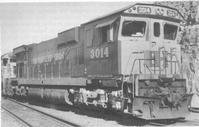


Chapter 7
I The First 100 Years 1788-1888
II Railways
i Location of the Railway
ii Track
iii Bridging and Tunnelling
iv Dams for Engine Water
v Locomotives and Rolling Stock
vi Signalling and Telecommunications
vii 1900/1988-The New Century
viii The Garratt Locomotive
ix Steam Locomotive Practice
x Motor Railcars
xi Signalling
xii Electric Tramways
xiii Electric Railways - Direct Current
xiv Electric Railways - 25 kV ac
xv Diesel Traction
xvi Alignment and Track
xvii Operations
III Motorised Vehicles
IV Aviation
V Modern Shipping
VI Innovative Small Craft
VII Conclusion
VIII Acknowledgements
IX Contributors
References
Index
Search
Help
Contact us

Diesel Traction (continued)
As the diesel developed, minor evolutionary modification in new models improved both locomotive reliability (to typically one incident per 50 to 80 thousand km), and engine examination period, top overhaul and major overhaul life (to typically 80, 200 and 800 thousand km) with corresponding improvements in reliability of auxiliaries. Power outputs steadily increased to 2000, 2200 and 2600 kW within the same physical size. As diesel engines developed, the V8 could replace the V12, and the V12 the V16, leaving the latter 'big' engines to handle only the highest powers (Fig. 13).
As power exceeded the 1500 kW ceiling the alternator/rectifier replaced the heavy dc generator. Traction motors were insulated for higher working temperatures with increased ratings that enabled lower continuous speeds uphill and superior (extended range) dynamic braking downhill, almost to the extent where a driver with time on his hands and economy in mind could, if he felt so inclined, elect to operate his train using the air brakes only for the final stop. These developments were matched by the introduction of control electronics and some electronic power-control gear; superior wheelslip and 'creep' control systems; further evolutionary improvement of auxiliaries and, post-OPEC, a steady improvement in engine fuel economy.
When coupled with electrical improvements they enabled heavier trains to be hauled by locomotives of the same mass and horsepower (albeit a trifle slower uphill) and further economies in terms of fuel, maintenance and ownership cost in terms of traffic task (i.e. per ton-km hauled.) In the Central Queensland coalfields, the benefits of multiple unit diesel operation were further extended beyond the normal capacity of wagon drawgear by the use of radio remote control Locotrol of unmanned, mid-train assisting 'consists' (blocks) of locomotives.
A feature unique to Queensland Railways was the ability to mix, via the Locotrol 'slave' wagon, incompatible types of English and American control gear in the same train (Locotrol technology will also be applied to the 25 kV ac electric locomotives that will replace diesel traction).
All of these basic technologies were imported -increasingly from America. Their application and detailed improvement, however, were Australian. Similarly, on the modern Australian diesel-electric locomotive only the diesel engine, main traction alternator and some control gear are imported -everything else being Australian made and in many cases of Australian design also. The flow of technology is not, however, entirely one way, as Clyde is developing and building a new narrow-gauge traction motor for EMD-GM, its licensor.
The diesel-electric locomotive also surprised everyone by its durability; as a result of meticulous maintenance one Clyde-GM unit is still in main-line traffic after nearly 7 million km operation in 34 years' service. Most people predicted a maximum of fifteen years, and studies by Westrail suggest this prediction is about the best economic life.
Organisations in Australian Science at Work - COMENG; Hamersley Iron
People in Bright Sparcs - Macfarlane, Ian B.
 |
Australian Academy of Technological Sciences and Engineering |  |
© 1988 Print Edition pages 480 - 481, Online Edition 2000
Published by Australian Science and Technology Heritage Centre, using the Web Academic Resource Publisher
http://www.austehc.unimelb.edu.au/tia/474.html